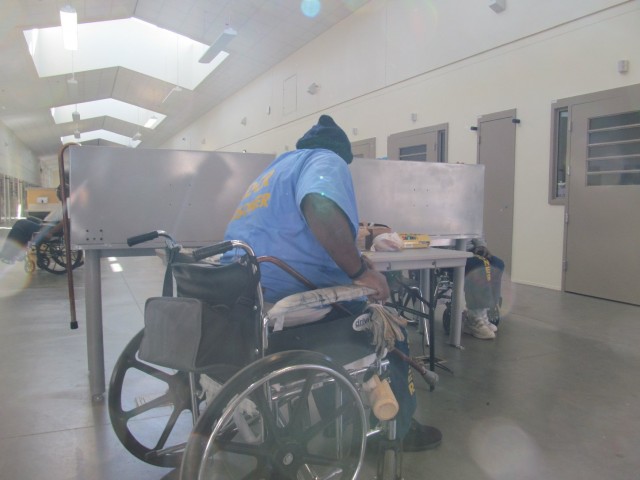Rebekah Evenson an attorney with the Prison Law Office who monitors conditions in the prisons, heard similar complaints when she visited last fall. She says many nurses lacked gauze and gloves. They couldn’t get the right size diapers and catheters for some incontinent inmates. “Diapers and catheters that don’t fit will leak” Evenson explained. “People were sitting in their own feces or urine because they didn’t have the basic supplies they needed.”
Evenson returned to the Stockton facility early this year and found the same problems. She also learned of a prisoner who had died there.
“He had pressed his call button,” she said, “and the prisoners who lived near him said staff just didn’t respond for a half-an-hour to an hour. By the time they arrived he’d already lost consciousness.”
Shortly after the inmate died, the federal receiver in charge of prison medical care halted new admissions at the facility. In court papers he accused prison officials of treating inmates' medical care as a “second-class priority.”
California Health Care Facility warden Ron Rackley disputes that charge.
“We certainly have an electrified fence, and we certainly have convicted felons," Rackley said, "but the primary mission here is to facilitate a high level of health care to the highest level of medical risk patients. We take that very seriously.”
Rackley declined to comment on the inmate death while the Department of Corrections and Rehabilitation investigates. He says some of the problems are being exaggerated and that the supply shortages were normal glitches that occur when opening a new facility.
“To state that the conditions were unsanitary as a generalization, I don’t think is fair and I don’t believe it’s an accurate assessment either."
Rackley said that many of the items staff said they couldn’t get their hands on were actually stocked in the warehouse on the edge of prison grounds.
On a tour of that warehouse, manager Derrick Greenwood explained that medical staff can re-order supplies using a bar code scanner. He said his staff can usually fill and deliver it on the same day. It’s an efficient system, he says, “if you do it correctly.”
The problem, Greenwood said, was a lack of training for medical staff placing orders.
Not all the problems at the California Health Care Facility relate to supply issues -- or even to the Department of Corrections and Rehabilitation.
It is the responsibility of the federal receiver to hire and manage medical staff and to set medical procedures and policies, such as how and when to respond when inmates hit their call buttons for help.
“We press the call buttons, they’re ignored,” said Anthony Enos, an inmate who lives on the unit adjacent to where the inmate died in January. “They won’t answer them in a timely fashion.”
Enos was convicted in Orange County for drug possession and carjacking. He thinks the prison needs more medical staff, so that they can respond immediately.
“You don’t know if a guy is choking on something, or having a hard time breathing, having a heart attack or what not,” Enos said.
But Jackie Clark, hired by the receiver as the new medical CEO of the Stockton facility, said that policies are clear. “We do have a written policy on that, and the policy is that the nursing staff will respond to call lights ‘as soon as possible.’”
The federal receiver transferred Clark to the facility in December and gave her full authority to hire more staff. Clark wouldn’t comment on the inmate who died but acknowledges she’s had to boost medical staff.
Clark also asked warden Rackley to increase the number of custody officers to escort inmates to medical appointments -- after Clark discovered nursing staff left their units to do that. “And so that practice I have stopped.” Clark said.
The Department of Corrections and Rehabilitation is working up a proposal to increase custody staff at the prison. If the state legislature approves the proposal, it would take effect in July.
The federal receiver hopes to reopen admissions at the California Health Care Facility in the next couple of weeks. Spokeswoman Joyce Hayhoe says they’ve sent teams to make recommendations.
“We’re talking to the staff and the inmates to determine if they are getting the necessary support and that things are running better," Hayhoe said.
The receiver’s teams recently found that supplies, such as gloves and catheters, are now getting to the units that need them.
“We’ve noticed a definite improvement since January. Now what we need to determine is -- are the improvements that we’ve made sustainable?" Hayhoe asked.
